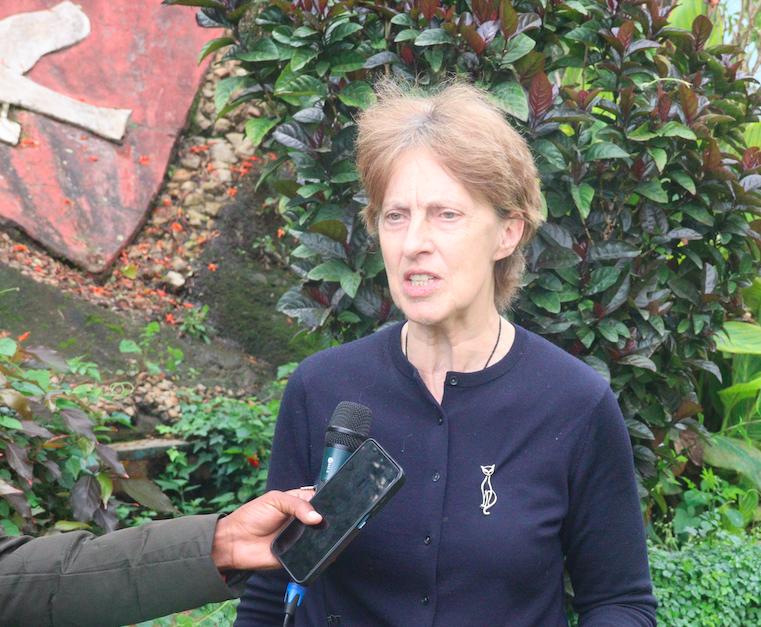

Prof Jacqueline McGlade of Strathmore Business School /GILBERT KOECH
The value of three water towers is set to be established following a partnership between the United Nations Environmental Programme and Strathmore University.
The partnership will establish the value of the natural capital beyond forest products and water resources.
“We are looking at supporting the government, policy makers and populations to embrace the importance of natural capital in decision making,” said Prof Jacqueline McGlade, investigator at the Strathmore Business School and the project lead researcher.
She spoke during a meeting with local communities in Berur, Bomet County.
Mau Forest complex, Cherangani and Loita water towers provide essential ecosystem services to the surrounding and far-end communities, but these areas face population encroachment, forest cover loss and expansion of agricultural land.
The Economics of Ecosystems and Biodiversity for Agriculture and Food (TEEBAgrifood ) seeks to equip decision makers with tools and information to recognise the value ecosystems provide.
McGlade said the project is helping establish the economic case for transforming food systems to become resilient to climate change and enhance environmental sustainability and improvement of human wellbeing.
She said the Teebagrifood project enables comparative evaluation of agricultural practices, production methods, climate and environmental impacts, changing consumption patterns and the effectiveness of policy and investment strategies.
Through the findings, there will be a transformation of food systems to become resilient to climate change and enhancement of environmental sustainability as well as improvement of human well-being.
The scenario, she says, has limited the capacity of the water towers to provide essential ecosystem services, resulting in biodiversity loss, reduced agricultural production and vulnerability in livelihoods.
McGlade praised previous efforts by the government towards finding a solution. But the value of the natural capital of these ecosystems is not known.
“This means the role of nature in delivering food security, biodiversity support, climate regulation, carbon sequestration cycles and other ecosystem services is not valued,” she says.
The professor said Stratmore University and Unep will be working with “citizen scientists” in collaboration with communities and other partners to generate date and evidence on the drivers of change in Kenya’s agrifood sector.
They will also create pathways to transform the food system to become more resilient to climate and socioeconomic shocks.
Kenya's water towers are important because they collect rainwater, regulate river flows and prevent runoff. They also recharge ground-water aquifers, improve soil fertility, reduce soil erosion and sediment loads in river water, regulate local climatic conditions for commercial agriculture and act as carbon reservoirs and sinks.
In addition, these catchment areas are instrumental in climate regulation, mitigating floods, conservation of biological diversity, nutrient cycling and soil formation.
Kenya’s food system currently faces extreme weather events, shifting rainfall patterns and global conflicts that disrupt commodity imports.
A decline in diverse exports further underscores the need for urgent, sustainable transformation across the agrifood value chain.
The project is also looking into the food and agriculture systems in the water towers that provide water regulation, soil conservation and biodiversity support.
“We want to generate economic evidence for positive policies and practices that enhance resilience and sustainability in Kenya’s food systems after conducting a thorough evaluation,” McGlade says.
A study conducted in Mau Forest conservation between 2017 – 2022 showed a decline in river networks with a total length shrinking from 7,000 km in the 1960s to 4,000 km in 2019.
But restoration efforts since 2022 that involved the planting of indigenous trees in riparian zones have helped recover 930 km of surface rivers.
Areas with higher soil carbon and less intensive farming were found to better withstand floods and droughts.
The new project is being undertaken in Nakuru, Baringo, Nandi, Narok, Kericho, Bomet, Uasin Gishu, Elgeyo Marakwet and West Pokot counties – regions that play a critical role in safeguarding and conserving critical ecosystems, habitats, species and cultures.
Agriculture and forestry are central to the project region, accounting for most earnings and providing livelihoods, employment, income and food security for most populations.
The project is expected to empower government officials’ capacity to measure and value the benefits and costs of decisions and translate those measures into coordinated policies that change food system incentives.











